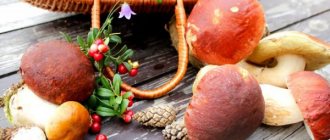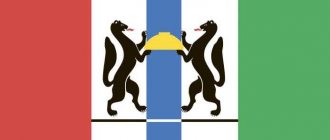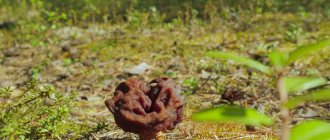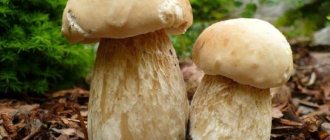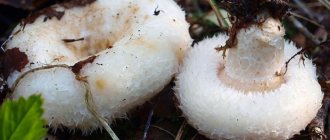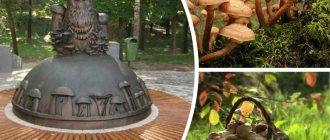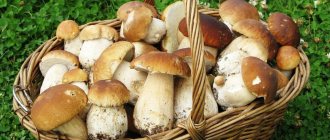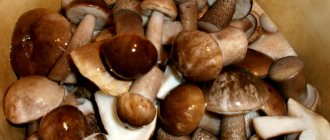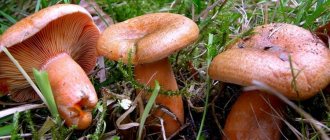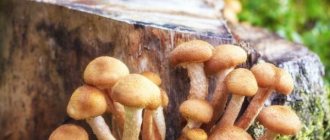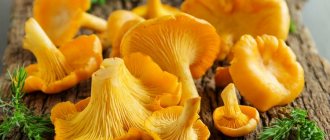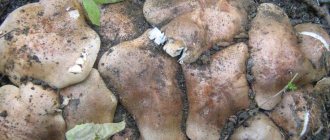The mountain taiga forests of the Urals are considered by local residents to be a treasure trove of mushrooms. The Sverdlovsk region has long been famous for the numerous places where these nutritious organisms grow. Thanks to this, mushroom pickers not only provide for their families, but also turn an exciting activity into an additional form of income. Unfortunately, due to chemical pollution of the atmosphere and soil, it has become dangerous to collect mushrooms in some places. This article provides information regarding areas that are abundant, but at the same time safe.
General information
The Sverdlovsk region can rightfully be called a favorable territory for mushrooms, because here they are found everywhere. An abundance of nutrient organisms is typically observed in the fall. However, after good rains, amateur mushroom pickers return with baskets full of chanterelles and chanterelles in July.
Honey mushrooms appear later, approximately in August. Their favorite places are deciduous and coniferous forests in mountainous areas. This is also where weeds, russula, milk mushrooms, saffron milk caps, and boletus grow.
To fill your baskets with boletuses, boletuses and redcaps, you need to travel along unexplored paths of damp meadow forests.
Lowland coniferous forests provide a suitable environment for the growth of greenfinches, saffron milk caps and umbrella mushrooms.
The capital Yekaterinburg is supplied with mushrooms, in particular the southern regions of the Sverdlovsk region. Porcini mushrooms are brought here from the Krasnoufimsky district. Sukhoi Log is a supplier of butter and white fruiting bodies. Artinsky district of russula and obabok, and Pervouralsky tract honey mushrooms. Mushroom pickers bring porcini mushrooms and milk mushrooms from the Sysertsky district.
In this area, mushrooms are mainly collected in the southern regions. But in the northern regions there are also many species of these organisms.
Classification of mushrooms
Mushrooms are divided into 4 groups:
- edible;
- conditionally edible;
- inedible;
- poisonous.
Forest gifts are classified according to their taste as follows:
- Category 1: mushrooms have a pronounced aroma and high taste characteristics (champignons, porcini mushrooms, milk mushrooms, saffron milk caps, oak mushrooms, chanterelles);
- Category 2: good edible mushrooms, slightly inferior in quality and taste to category 1: (boletus, boletus, aspen, morels,). Most often, these mushrooms are used to prepare snacks and pates;
- Category 3: mushrooms that are collected under the condition that there are no better ones or very few (moss mushrooms, milkweeds, tremors, honey mushrooms, russula)
- Category 4: have low taste (raincoats, oyster mushrooms, umbrellas)
Before cooking, mushrooms belonging to categories 3 and 4 require preliminary heat treatment with a change of water.
We inherited this category from the times of the USSR. Now they are trying to move away from it, and for each type of mushroom their nutritional (energy) value is indicated. Therefore, the same mushroom can be listed in different categories, depending on the degree of its popularity in cooking.
Variety of mushrooms
The variety of mushrooms in this area is simply impressive. The climatic conditions and nature of the Sverdlovsk region favor the growth of various types of fruiting bodies, with different harvest times. Here you can find milk mushrooms, boletus, chanterelles, red cap mushrooms, porcini mushrooms, boletus mushrooms, boletus mushrooms, boletus mushrooms, red cap mushrooms, and honey mushrooms. These are the names that are more common in the south.
Many of the listed species grow in the Northern Urals. However, besides them, there are others that are not in the southern regions. Here is a complete list of the names of northern mushrooms: oiler, milk mushroom, boletus, goat, chanterelles, boletus, moss fly, false chanterelle, saffron milk cap, porcini mushroom, volushka, honey mushrooms and edible russula.
Obviously, this region is famous not only for the diversity of these nutritional organisms. The mushrooms of the Sverdlovsk region have wide boundaries. If you have the view of a mushroom picker, then the Urals can be divided into three zones: forest-steppe, swampy forests and dry copses.
What mushrooms grow in the Sverdlovsk region?
Favorable climate, good soil and a huge area of mixed forests annually give mushroom pickers a good harvest. “Hunters” come out of the forest with full baskets and buckets of edible mushrooms, regardless of the time of year. Calm is observed only in cold weather, when the air temperature drops to sub-zero temperatures and the ground is covered with a centimeter layer of snow.
Mushrooms in the beautiful region are divided into four categories:
- edible;
- conditional (allowed for consumption after proper processing);
- inedible;
- poisonous.
The first two categories are the most relevant during the off-season. Going in search of fruitful clearings, mushroom pickers hope that they will be able to collect boletus, aspen, saffron milk caps and boletus, not only for food, but also to prepare for the winter. And if you are lucky enough to come across a family of honey mushrooms and white mushrooms, then collecting several buckets at a time will not be difficult.
Mushroom pickers divide the mushrooms of the Sverdlovsk region into tasty and aromatic, less tasty and conditionally edible, which can be collected in a bucket in the absence of valuable fruits. The first list contains: the white family and their varieties, champignons, saffron milk caps, milk mushrooms and mushrooms. The second list includes: honey mushrooms, boletus, chanterelles, morels and hydrophores. Last on the list are conditionally edible mushrooms that require special heat treatment. Some of them are boiled several times, draining the water each time, and then cooked. Others are soaked for several days, and then boiled and pickled for the winter.
Forest-steppe
The territory covers the eastern outskirts of the Krasnoufimsky district, the western outskirts of the Nizhnesiginsky district, as well as some surrounding areas of Kamensky. This includes the following districts: Kamyshlovsky, Tugulymsky, Talitsky, Bogdanovichsky, Pyshminsky. This is a mountainous area consisting of steppes and fields, characterized by copses.
The growth of mushrooms in fields and steppes directly depends on the amount of precipitation. During the rainy season, the steppe region is rich in returns. Chanterelles, boletus and milk mushrooms seem to jump out of the ground.
Rare
On the territory of the Sverdlovsk region there are also species listed in the Red Book of the region. There are 13 of them. They are extremely rarely seen by people, but under favorable weather conditions they can be seen (especially in damp forests).
These include psilocybin mushrooms, representatives of the Phallus and Polyporaceae families. Most of them are inedible, but they are so rare that they are even under state protection:
- sheep's albatrellus;
- Haploporus odorant;
- ishnoderma resinous;
- clavariadphus truncated;
- clavaria is pale brown;
- Climacodon northern
- Onnia tomentosa, etc.
Forests with high humidity
Damp forests cover a decent part of the West Siberian Lowland. This is an inaccessible area, which is not easy to get into due to urmans and swamps. And yet it should be recognized that it is the most favorable area for the growth of mushrooms due to the swamps.
If you master this area and find safe paths, you can collect a huge number of edible fruiting bodies. The wet forests of the Sverdlovsk region allow local residents to stock up on mushrooms for future use. They are collected in such areas as Alapaevsky, Garinsky, Krasnouralsky, Taborensky, Serovsky. This region is also adjacent to many parts from other nearby areas.
Poisonous
Almost every edible specimen has an inedible or even poisonous counterpart. Their external similarity can be so strong that even experienced mushroom pickers sometimes have difficulty distinguishing them from each other. The following types of poisonous mushrooms are often found in the Sverdlovsk region:
- gall and satanic mushroom;
- fly agaric;
- false honey fungus and chanterelle;
- inedible yellow-skinned champignon;
- death cap.
Gall and satanic are dangerous doubles of the porcini mushroom. They can be distinguished by their blue (pink) cut and bitter taste, which does not disappear even after prolonged heat treatment. You should be especially careful with the satanic mushroom, which contains a large amount of toxic substances.
In order not to confuse the white mushroom with the satanic one, it is important to know some of its features:
- cap: the color of its surface depends on the light and the place of growth (can be grayish-white, olive or brown). Velvety in appearance;
- tubular hymenophore: orange or any shade of red;
- leg: the loops of the mesh pattern are more or less round; the color of the surface of the leg is reddish or even carmine red;
- pulp: turns blue when broken, and then restores its original (white or slightly yellowish color); Attention! It is better to check the presence of blue on the cut immediately in the forest.
- smell: old mushrooms resemble the smell of rotten onions.
The false chanterelle is identified by its red-orange cap, which seems to be turned outward. When cut or broken, the flesh turns pink.
Pale toadstool or false honey mushrooms are confused with edible honey mushrooms. Toadstool is especially dangerous: consuming even a small amount can be fatal. The “skirt” on the leg will help to distinguish it from a good mushroom. The false foam does not have such a ring, and the shade of the cap is more saturated - reddish or orange.
False champignons, which are very similar to edible ones, have an unpleasant, “pharmacy” (carbolic acid) odor. Also, after cutting, the flesh becomes yellow.
Mushroom places
Based on available data from Internet portals and from the words of experienced mushroom pickers, it is possible to get a general picture of what mushrooms are found in certain areas of the Sverdlovsk region. Relying on this information, we provide an indicative list of areas where you can confidently go for mushrooms. Here they are - mushroom places of the Sverdlovsk region:
- The Tugulym region is very rich in porcini mushrooms and milk mushrooms. In these surroundings you can always see local sellers with baskets of mushrooms along the roads.
- In the Chelyabinsk region, volnushki grow very amicably.
- In the vicinity of Beloyarsk there are honey mushrooms.
- The Sukholozhsky region is famous for the growth of chanterelles, boletus and porcini mushrooms.
- Kamensky is rich in boletus and white boletus.
- Krasnoufimsky boletus, chanterelles, milk mushrooms, boletus.
- Alapaevsky with boletus and chanterelles.
- Sysertsky milk mushrooms.
There are many well-known villages where there is no need to conduct a thorough search. Mushrooms just beg to be included in the basket. These are Bobrovka, Karavashka, Verkhneye Dubrovo, as well as the environs of Berezovsk and Verkhnyaya Pyshma.
Trust but check
Many mushroom pickers, following the proverb “if there is no fish, there is cancer,” they also collect conditionally edible mushrooms, which must be soaked or boiled for several hours before cooking. For example, valui or milkmen, better known among the people as “bulls” and “creaks”. These mushrooms are unpleasant to taste due to the bitter milky juice that causes stomach upset. But the juice of Russula stingum, which looks similar to ordinary red russula, can cause serious poisoning with hospitalization. Unlike the edible russula, the pungent one has a watery stem, without a mushroom smell, and the edges of the cap are ribbed.
“Under no circumstances should you collect mushrooms that you do not know or are not sure are edible,” says biologist Ekaterina Zherebtsova . – Be careful, don’t mindlessly take all the mushrooms in a row. This is especially true for rare mushrooms. For example, there is no need to collect the “ram mushroom” (scientifically called curly sparassis), which grows in the forests southwest of Yekaterinburg and is listed in the Red Book of Russia. Or an umbrella mushroom (a close relative of champignons): unknowingly it can be confused with the panther fly agaric, similar to the umbrella mushroom in color and cap pattern.
In addition, it is important to remember that due to the peculiarities of their biological structure, mushrooms easily absorb harmful substances from the environment - heavy metal compounds and radionuclides. Therefore, you should not collect them along railways and highways, on former slag and ash dumps, or near power plants. And even more so in places exposed to radioactive contamination due to the accident at Mayak in 1957. These are the outskirts of Kamensk-Uralsky and certain territories of Kamensky, Pyshminsky, Kamyshlovsky, Talitsky and Bogdanovichsky districts. The risk zone also includes the outskirts of Krasnoufimsk, the villages of Kostousovo and Ozerny in the Rezhevsky district, where there are outcrops of radioactive monocyte sands. However, there are still those who pick mushrooms there and then sell them. Therefore, you should also be wary of mushroom sellers, and it is better to go into the forest with a basket yourself.
In the vicinity of Yekaterinburg you can find mushrooms for every taste Photo: Stanislav Mishchenko
COMMENTS
- Evgeniy ANUFRIEV, mushroom picker from Yekaterinburg:
– I would advise going for mushrooms to the northwest of Yekaterinburg towards Pervouralsk. The journey by train takes 40–50 minutes, there are excellent places near the Reshety, Sportivnaya, Novoalekseevskaya stations. There are all sorts of mushrooms there: a huge number of mushrooms, boletuses, butter mushrooms, milk mushrooms, but there are few white ones. There are also good places near Sysert and in the area of the station 40 kilometers southeast of Yekaterinburg; there are more than enough mushrooms in those parts.
- Alexander MARTYANOV, mushroom picker from Bogdanovich:
– When it’s a good, warm year, there are tons of mushrooms everywhere. And boletus, and saffron milk caps, and milk mushrooms, and white mushrooms, and honey mushrooms - everything is there, you just need to know where to look. I myself come from Kamyshlov, and there are many mushroom glades there. There was a time when we went for mushrooms not with buckets, but with potato bags. There used to be a sign: if there is a lot of poplar fluff, then expect a lot of mushrooms and cucumbers. And now there seems to be a lot of fluff, but not enough mushrooms and cucumbers. This is all because people have become too mobile: sometimes you come to the forest, and there are more cars there than mushrooms. But in any case, everyone who travels to our region always picks up a couple of buckets of boletus or milk mushrooms, there is no problem with that.
This is what a ram mushroom looks like. There is an administrative fine for collecting it Photo: Stanislav Mishchenko
Published in No. 131 of 07/26/2019
What you need to know for a successful search
Now that we have found out where there are mushrooms in the Sverdlovsk region, let's talk about how to look for them correctly. From the practical wisdom of experienced mushroom pickers, several important points can be highlighted:
- If you climb into a spruce forest, your reward will be full buckets of saffron milk caps and buttermilk. Low forests serve as a storehouse for these mushrooms.
- Boletuses and boletuses are hiding in the grass. However, a suitable environment for their reproduction is humidity. In dry weather, do not expect to carry out mass collection of mushrooms of this species.
- You can go for honey mushrooms only after the cold nights arrive. Usually this time coincides with the beginning of the first frost. These are the conditions for honey mushroom growth that are most suitable.
- The first snowfall is the time of purple rows. Entire families of these edible and quite tasty organisms are hidden under a small snow cover.
- People who collect mushrooms warn that in some areas it is dangerous to collect them. It is better not to do this in the central parts of cities and environmentally polluted places. Such areas include Asbest, Pervouralsk, Rezh, Artemovsky and Revda. You should definitely study the map, which shows zones of chemical and environmental pollution. Most dangerous places are localized in dry groves.
Kinds
Before you go hunting, you should carefully study edible and poisonous mushrooms. Having learned to distinguish false species from tasty and healthy ones, the beginner will be calm for his life, loved ones and friends who treated themselves to the harvested forest harvest.
Important! It is better to go hunting when the thermometer drops below 20 degrees, and it rains a few days before going into the forest. Otherwise, the mushrooms will not have time to grow.
Edible mushrooms
From early spring, in mixed forests you can find bunches of boletus and boletus, and come across varieties of russula, morels and stitches. And with the ability to distinguish champignons from poisonous toadstools, collect the most valuable agaric cultures for frying and stewing.
From the beginning of May to the end of July, other types of edible mushrooms begin to grow:
- summer boletus germinates in tall grass and near coniferous trees;
- chanterelles and porcini mushrooms - in mixed and deciduous forests;
- boletus trees - next to birch trees;
- boletuses - next to aspen trees;
- saffron milk caps - in well-sanctified places, close to ditches, lakes and swamps;
- wavelets - in birch groves and mixed forests.
From August until the end of October, forests delight mushroom pickers:
- autumn honey mushrooms;
- hydrophores;
- values;
- goats;
- mushroom valui;
- oyster mushrooms
At the beginning of winter, you can go hunting for purple rowers. The most important thing is not to confuse them with goat’s web, which is classified as “inedible mushrooms.”
Poisonous mushrooms
In the forest you need to be careful and make sure that the poisonous mushroom does not fall into the basket. After all, often false or poisonous mushrooms grow in an edible meadow, which are prohibited for consumption due to the large number of carcinogens and poisons. Today in the Sverdlovsk region there are 7 most common mushrooms that are included in the list of “inedible” and dangerous to human health.
- The top opens with the pale toadstool, which often grows in the vicinity of boletus, hydrophores and honey mushrooms. It’s very easy to accidentally put it in your cart. Therefore, you should collect mushrooms more carefully, and if you find a toadstool in the basket, throw away the entire harvest.
- Red fly agaric is most often confused with red-capped russula. The reason for this is heavy rains, washing away the pronounced white spots on the cap.
- The gall mushroom is very often confused with a variety of boletus mushrooms. But there is one difference. When cut, the mushroom first acquires a pink color, and after a while a blue tint, reminiscent of spilled blue. It is impossible to confuse this color with others...
- False honey mushrooms very often grow on old, dry and dilapidated stumps, around tree trunks and holes. A distinctive feature from edible mushrooms is their sulfur-yellow color.
- The satanic mushroom has a bright red stem and a nasty aroma that repels even a novice mushroom picker from prey.
- For the first time, you should not go looking for chanterelles alone. Similar features to the false brother can confuse even an amateur. The main thing to remember is that the edible chanterelle has a more yellow tint, while the poisonous one has an orange tint.
- The rating is closed by a champignon double, which has a repulsive aroma, reminiscent of rotten food and a yellowish tint in the cut.
Brief description of some types
A novice mushroom picker needs to learn to distinguish the external signs of edible mushrooms. Undoubtedly, only many years of experience will help to distinguish them correctly and quickly. But for now we would like to introduce you to a brief description of some types of mushrooms in the Sverdlovsk region.
- White. Compared to other organisms, it stands out for its taste, aroma and fleshy pulp. In cross section, its body is white and does not change during heat treatment. The leg is thick, the color of the cap varies from light beige to deep brown. In particular, color depends on the location and environment of their growth.
- Russulas are the most popular mushrooms in the northern Urals. They are found everywhere and grow until the coldest weather. The color can be different - from soft green to purple and even red. The spherical small cap of the young russula begins to level out as it grows. By the time it ripens, its edges turn up a little.
- Chanterelles. The favorite places of these mushrooms are mixed forests. The rare-shaped body has a yellow-orange color and a funnel-shaped cap, fused with the stem. Chanterelle is a family mushroom, so it rarely grows alone. Over the entire mushroom period, it produces two waves of harvest: the first in June, the second from August to the end of October.
- Milk mushrooms. Milky organisms belong to the Russula family. Wet mushrooms are another name for milk mushrooms, due to their ability to secrete juice at the break point. Their color is almost white, their cap is somewhat concave, and they are good for pickling.
- Boletuses, also known as redheads. A distinctive feature of their bodies is a powerful, stable leg, which turns slightly blue when cut. Hats are white and orange.
Common edible species of the Sverdlovsk region
In a favorable year, lovers of forest walks can carry away several buckets of mushrooms filled to the top from one clearing. The main thing is to choose suitable types for consumption that have a pleasant aroma and good taste, and also do not contain toxic substances.
Boletus
The mushroom is extremely healthy and has good taste. Boletus is quite rare. Its dense hemispherical or flat cap can be red, white, yellow or gray. It is attached to a dense stalk covered with thick scales (up to 20 cm). In the forests, boletus can be found until the first frost.
boletus
There are more than 40 varieties of the variety, which are very similar in appearance. The color of the cap changes as it grows, so it gradually turns from white to dark brown. The white leg is quite high (up to 15 cm) and covered with dark gray scales. Mushrooms grow quickly, their full maturity occurs on the 6th day after germination. After this, the boletus becomes a delicacy for the worms.
Oiler
The name of the mushroom speaks for itself and does not allow it to be confused even with related species. The cap is covered with a slimy skin, as if it had been smeared with vegetable oil. Its color varies from chocolate brown to yellow-brown. The leg reaches 4-12 cm, has a light color and a white ring.
Kozlyak
You can meet it from August until the last days of September in coniferous forests near pine trees. The fruit has a brown, brown or red slightly swollen cap, which straightens as it matures. The cylindrical stem is the same shade as the skin on the cap, but more matte. The taste of goat is not very good - the mushroom is eaten after a short heat treatment.
Gruzd
If a mushroom picker comes across a mushroom, it is quite difficult to miss it, since the cap sometimes reaches 20 cm. Depending on the type, it can be yellow, white, brown or reddish. In young specimens, the shape of the cap is flat, and with age it becomes funnel-shaped. The fruits always have a lot of plant debris that accumulates in the cap.
Russula
Attention is drawn to the mushrooms by a bright cap of different shades with a diameter of up to 20 cm. It can be spherical, hemispherical, or bell-shaped and is attached to a white, smooth stem. On the back of the cap you can find many whitish plates. As the fetus grows, the cap becomes funnel-shaped. Its peculiarity is its fragility, which reduces the economic value of russula.
Ryzhik
Mushroom pickers take special pleasure in bringing home saffron milk caps, as their taste is comparable to boletus mushrooms. Externally, they are represented by a wide funnel-shaped cap, which is covered with dry, smooth, ocher-orange skin. The leg is quite fragile and cylindrical in shape. Its color is no different from the cap.
Volnushka
Incredibly interesting mushrooms that attract attention with their color. The funnel-shaped cap has a pattern in the form of waves diverging in different directions. Their color can be pink or yellow, while the leg has the same shade. Volushka is very popular in Russia, but in the West it is not recommended for consumption.
Chanterelles
The main advantage of the mushroom is not only its excellent taste, but also its high resistance to parasites. Therefore, the probability of encountering wormy chanterelles tends to zero. The hat has a rather non-standard shape, which can be concave or convex. Its color is yellow or orange. The stable leg smoothly transitions into the cap and has the same shade as it.
Porcini
The king of the forest has gained immense popularity among mushroom pickers due to its exquisite taste. It can be used in various culinary experiments. You can recognize the porcini mushroom by its matte, slightly convex top, which can be reddish, brownish, yellowish, lemon and dark orange. The leg expands downward and is usually light brown in color.
Honey mushrooms
The fruits got their name due to the peculiarity of their growth, since they literally ring the stump. Their cap resembles a dome, with rounded ends and scales throughout the surface, and the honey color is combined with a light brown thin stem.
Mosswort
An adult specimen is very easy to confuse with boletus, and a young specimen with boletus. The upper part of the mushroom has a rounded shape, which becomes cushion-shaped or flat with age. Its color also changes from light golden to cherry brown. The leg can be elongated or stocky, depending on the immediate location.
How to recognize unsuitable mushrooms
Before you go into the forest, you need to study what edible mushrooms look like and find out the characteristics of toadstools. Here are some types of poisonous mushrooms in the Sverdlovsk region:
- Undoubtedly, the easiest way to distinguish a fly agaric is by its beautiful cap. The motley red crown with white specks gives it away from afar.
- But false foam poses a danger to uninformed mushroom pickers. It is distinguished by the color of the plates. Good mushrooms have a creamy color and do not darken. In the poisonous brick honey fungus, the plates are slightly lighter and become brown over time. Gray-yellow false foam has plates of the same color.
- The pale grebe is distinguished by the presence of a skirt. Many other poisonous mushrooms have the same structure.
- A great similarity was noticed between the gall fungus and the white one. This type of grebe has a tubular layer under the cap that is dirty pink in color. A mesh pattern is visible on the leg.
- Anyone can recognize a false fox - it is very similar to its double, although it does not belong to this family. Not so long ago it began to be classified as a conditionally edible mushroom body. And yet, these mushrooms are not recommended to be eaten, since they are very poorly absorbed by the body and cause serious problems associated with digestion.
Benefits of mushrooms
According to many scientists, many types of mushrooms contain large amounts of vitamins, minerals, macro- and microelements necessary for every person for growth and development. Eating edible mushrooms can replace the consumption of meat and fish, many vegetables, fruits and berries. The most important thing is to know which type of mushroom is the most beneficial.
Another benefit of mushrooms is their low calorie content. They can be consumed even by people on a strict diet, those suffering from obesity and diabetes.
Properties
Mushrooms can replace meat
Mushrooms are unique forest organisms that have a lot of beneficial properties. They are determined by their chemical composition.
Benefit
Due to the large amount of proteins, mushrooms can replace animal meat. It is especially valuable for vegetarians who do not receive enough animal proteins necessary for the normal functioning of the body.
Low calorie content makes it possible to use this product for obesity.
A huge amount of vitamins, microelements and amino acids helps in the manufacture of medicines.
Regular consumption of them is a necessity for diabetics, because... mushrooms lower blood sugar levels.
For older people, they help stimulate brain function.
Harm
Dishes with the addition of mushrooms are considered difficult for the stomach, because chitin, which is part of the cell walls of mushrooms, inhibits the functioning of the gastrointestinal tract, and problems may arise associated with the development of food rotting processes in the gastrointestinal tract. This product is also considered allergenic.
Mushrooms absorb all toxins from the environment, so it is important to choose the right environmentally friendly area for collection.
